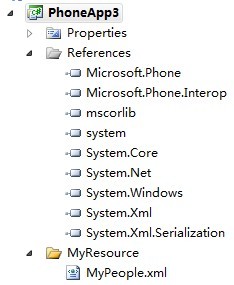WP7编程 读取外部XML文件中存放的记录
Kagula
2011/8/9
内容简介
我准备写个简单的WP7程序,需要读取我在项目外部设置的XML文件中的记录集,作为Silverlight初学者,途中碰到了很多问题,现在把它记录下来,备查。
测试环境:[1]Visual2010+SP1
[2]Windows Phone SDK
正文
第一步:确定XML文件的格式
S1-1:先定义单条记录结构对应的C#代码
示例源码如下:
public class Person
{
string firstname;
string lastname;
int age;
public string FirstName
{
get { return firstname; }
set { firstname = value; }
}
public string LastName
{
get { return lastname; }
set { lastname = value; }
}
public int Age
{
get { return age; }
set { age = value; }
}
}
上面的记录有firstname、lastname、age三个字段组成。
S1-2:确定多条记录对应的C#代码
因为有多条记录组成,所以要使用下面的示例代码,确定多条记录情况下XML文件内容的格式,下面是示例代码,我们这里随便插入了三行记录
private List<Person> GeneratePersonData()
{
List<Person> data = new List<Person>();
data.Add(new Person() { FirstName = "Kate", LastName = "Brown", Age = 25 });
data.Add(new Person() { FirstName = "Tom", LastName = "Stone", Age = 63 });
data.Add(new Person() { FirstName = "Michael", LastName = "Liberty", Age = 37 });
return data;
}
S1-3:现在记录集对应的的C#代码有了,下面的代码生成该记录集对应的示例XML文件内容
using System.Xml;
using System.Xml.Serialization;
using System.IO.IsolatedStorage;
using System.IO;
//这里省略若干行代码
private void writeToXML()
{
XmlWriterSettings xmlWriterSettings = new XmlWriterSettings();
xmlWriterSettings.Indent = true;
StreamWriter stream = new StreamWriter("People.xml");
XmlSerializer serializer = new XmlSerializer(typeof(List<Person>));
using (XmlWriter xmlWriter = XmlWriter.Create(stream, xmlWriterSettings))
{
serializer.Serialize(xmlWriter, GeneratePersonData());
}
}
把上面几段代码插入到新建的WindowsForm项目中并运行会生成People.xml文件,查看这个文件有我们需要的XML文件格式。我们可以修改这个XML文件插入我们实际的记录集内容。
第二步:WP7项目中引入这个XML文件,并读取其内容
S2-1:在WP7项目的References结点中添加”System.Xml.Serialization”库
S2-2:在WP7项目中新建文件夹,起名为“MyResource”在该文件夹下新建MyPeople.xml,用我们刚才生成的People.XML文件的内容,替换MyPeople.xml中的内容。
MyPeople.xml的Copy to Output Directory属性得设成Copy if newer。
参考下图

S2-3:WP7项目中使用下面的代码读取MyPeople.xml中的内容
try
{
Uri uri = new Uri("MyResource/MyPeople.xml", UriKind.Relative);
StreamResourceInfo sri = Application.GetResourceStream(uri);
if (sri!=null)
{
XmlSerializer serializer = new XmlSerializer(typeof(List<Person>));
List<Person> data = (List<Person>)serializer.Deserialize(sri.Stream);
this.listBox.ItemsSource = data;
}
}
catch
{
//add some code here
}
上面代码中的“listBox”控件由下面XAML的代码段定义
<ListBox x:Name="listBox">
<ListBox.ItemTemplate>
<DataTemplate>
<StackPanelMargin="10" >
<TextBlockText="{Binding FirstName}"/>
<TextBlockText="{Binding LastName}"/>
<TextBlock Text="{BindingAge}"/>
</StackPanel>
</DataTemplate>
</ListBox.ItemTemplate>
</ListBox>
总结
通过上面的代码我们实现了从我们手工定义内容的XML文件中读取记录集。这里要注意的是[1]在WP7中使用的Stream Class同在WinForm项目中使用的Stream Class类型的不同。[2]借助第一步生成XML文件结构,然后在这个结构上我们把自己记录的内容替换上去,这样解析XML文件的时候,才不会出错。
下面附WP7项目中MainPage.xaml.cs的源码
using System;
using System.Collections.Generic;
using System.Linq;
using System.Net;
using System.Windows;
using System.Windows.Controls;
using System.Windows.Documents;
using System.Windows.Input;
using System.Windows.Media;
using System.Windows.Media.Animation;
using System.Windows.Shapes;
using Microsoft.Phone.Controls;
using System.Xml;
using System.Xml.Serialization;
using System.IO.IsolatedStorage;
using System.IO;
using System.Windows.Resources;
namespace PhoneApp3
{
public class Person
{
string firstname;
string lastname;
int age;
public string FirstName
{
get { return firstname; }
set { firstname = value; }
}
public string LastName
{
get { return lastname; }
set { lastname = value; }
}
public int Age
{
get { return age; }
set { age = value; }
}
}
public partial class MainPage : PhoneApplicationPage
{
/*
private List<Person> GeneratePersonData()
{
List<Person> data = new List<Person>();
data.Add(new Person() { FirstName = "Kate", LastName = "Brown", Age = 25 });
data.Add(new Person() { FirstName = "Tom", LastName = "Stone", Age = 63 });
data.Add(new Person() { FirstName = "Michael", LastName = "Liberty", Age = 37 });
return data;
}
private void writeToXML()
{
XmlWriterSettings xmlWriterSettings = new XmlWriterSettings();
xmlWriterSettings.Indent = true;
using (IsolatedStorageFile myIsolatedStorage = IsolatedStorageFile.GetUserStoreForApplication())
{
using (IsolatedStorageFileStream stream = myIsolatedStorage.OpenFile("People.xml", FileMode.Create))
{
XmlSerializer serializer = new XmlSerializer(typeof(List<Person>));
using (XmlWriter xmlWriter = XmlWriter.Create(stream, xmlWriterSettings))
{
serializer.Serialize(xmlWriter, GeneratePersonData());
}
}
}
}
private void readFromXML()
{
try
{
using (IsolatedStorageFile myIsolatedStorage = IsolatedStorageFile.GetUserStoreForApplication())
{
using (IsolatedStorageFileStream stream = myIsolatedStorage.OpenFile("People.xml", FileMode.Open))
{
XmlSerializer serializer = new XmlSerializer(typeof(List<Person>));
List<Person> data = (List<Person>)serializer.Deserialize(stream);
this.listBox.ItemsSource = data;
}
}
}
catch
{
//add some code here
}
}
*/
// Constructor
public MainPage()
{
InitializeComponent();
//writeToXML();
//readFromXML();
try
{
Uri uri = new Uri("MyResource/MyPeople.xml", UriKind.Relative);
StreamResourceInfo sri = Application.GetResourceStream(uri);
if (sri!=null)
{
XmlSerializer serializer = new XmlSerializer(typeof(List<Person>));
List<Person> data = (List<Person>)serializer.Deserialize(sri.Stream);
this.listBox.ItemsSource = data;
}
}
catch
{
//add some code here
}
}
}
}
参考资料
[1]《WP7 Isolated Storage详解(5)-通过XmlSerializer读写XML文件》
http://www.cnblogs.com/zdave/archive/2011/05/23/2054344.html























 1万+
1万+

 被折叠的 条评论
为什么被折叠?
被折叠的 条评论
为什么被折叠?










